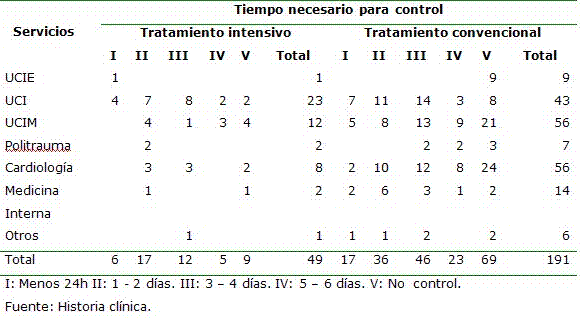Tratamiento insulínico intensivo versus convencional de la hiperglucemia en el paciente grave
Keywords:
DIABETES MELLITUS/terapia, GLUCEMIA, CUIDADOS INTENSIVOS, ATENCIÓN AL PACIENTE, ESTUDIOS OBSERVACIONALES, ANCIANO.Abstract
RESUMENFundamento: la hiperglucemia en pacientes en estado crítico se considera un signo de mal pronóstico por lo que es necesario un control glucémico estricto, donde el tratamiento intensivo con insulina es más usado.
Objetivo: proponer un esquema de tratamiento insulínico intensivo para el control glucémico en pacientes graves.
Método: se realizó un estudio prospectivo observacional en 240 pacientes ingresados en los servicios de atención al grave del Hospital Universitario Manuel Ascunce Domenech desde de junio de 2008 hasta septiembre de 2008, los que representaron el 22,3 % del total de los pacientes ingresados en estas unidades, 125 mujeres y 115 hombres con predominio del grupo de edad de 66 años y más. Se incluyeron todos los pacientes que presentaron dos glucemias mayores de 7,8 mmol/l en las primeras 12h del ingreso y se les aplicó según criterio del médico de asistencia, tratamiento hipoglucemiante intensivo o convencional.
Resultados: el tratamiento hipoglucemiante intensivo se utilizó en el 20 % de los casos, reportándose en estos un menor tiempo para lograr el control glucémico. La estadía hospitalaria en este grupo fue menor en un 25 % en comparación con la del grupo que recibió tratamiento convencional.
Conclusiones: el tratamiento hipoglucemiante intensivo demostró ser eficaz en pacientes graves con hiperglucemia.
Downloads

Downloads
Published
How to Cite
Issue
Section
License
Copyright: Camagüey Medical Archive Magazine, offers immediately after being indexed in the SciELO Project; Open access to the full text of the articles under the principle of making available and free the research to promote the exchange of global knowledge and contribute to a greater extension, publication, evaluation and extensive use of the articles that can be used without purpose As long as reference is made to the primary source.
Conflicts of interest: authors must declare in a mandatory manner the presence or not of conflicts of interest in relation to the investigation presented.
(Download Statement of potential conflicts of interest)
The Revista Archivo Médico de Camagüey is under a License Creative Commons Attribution-Noncommercial-No Derivative Works 4.0 International (CC BY 4.0).
This license allows others to distribute, to mix, to adjust and to build from its work, even for commercial purposes, as long as it is recognized the authorship of the original creation. This is the most helpful license offered. Recommended for maximum dissemination and use of licensed materials. The full license can be found at: https://creativecommons.org/licenses/












 22 julio 2025
22 julio 2025